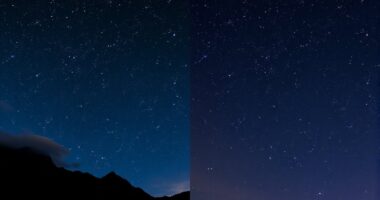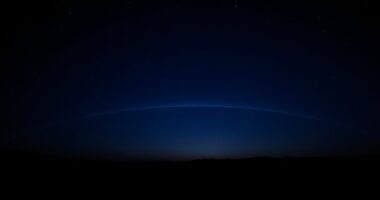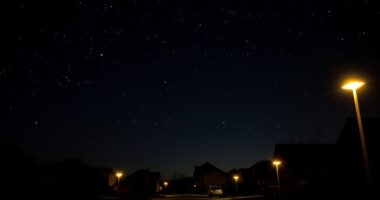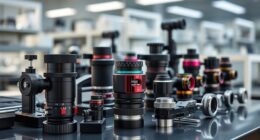To predict your own aurora show, you need to monitor solar activity like sunspots, solar flares, and coronal mass ejections, which influence geomagnetic storms that cause the lights. Keep an eye on space weather forecasts and KP indices, and watch for clear, dark skies in high-latitude areas. Good planning and awareness of atmospheric conditions boost your chances. For more tips on tracking and maximizing your aurora experience, continue exploring these helpful insights.
Key Takeaways
- Monitor solar activity indicators such as sunspots, solar flares, and CMEs using space weather forecasting tools.
- Track the KP index and geomagnetic forecasts to assess aurora potential and strength.
- Check local weather and cloud cover forecasts to ensure clear skies for visibility.
- Plan your viewing during peak geomagnetic activity, typically around winter months and during magnetic storms.
- Use dedicated aurora alert apps and websites for real-time notifications on aurora forecasts and optimal viewing times.
Understanding the Science Behind the Northern Lights

The Northern Lights, also known as the Aurora Borealis, occur when charged particles from the sun interact with Earth’s magnetic field. As these particles collide with gases in the atmosphere, they produce the stunning, colorful displays you see in the night sky. Throughout history, many cultures have created aurora myths to explain this natural phenomenon, often viewing it as spirits dancing or messages from the gods. The cultural significance of the Northern Lights varies worldwide, symbolizing everything from divine intervention to omens of change. Understanding the science behind these lights helps you appreciate their beauty beyond myth, revealing how solar activity and Earth’s magnetic shield work together. This knowledge enhances your ability to predict when and where to witness this breathtaking natural spectacle. Additionally, sustainable living practices can help reduce pollution that may affect atmospheric conditions, indirectly supporting clearer views of natural phenomena like the Aurora Borealis.
Key Factors Influencing Aurora Visibility

Several key factors determine whether you’ll catch a glimpse of the Northern Lights. One major element is geomagnetic fluctuations, which energize Earth’s magnetic field and create auroras. When these fluctuations are strong, the chances of seeing vibrant displays increase. Atmospheric conditions also play a pivotal role; clear, dark skies free of light pollution are essential for visibility. Cloud cover can obscure the lights, while moonlight may diminish their brightness. Additionally, your location matters—being closer to the magnetic poles improves your chances. Weather patterns and atmospheric clarity influence how well you can observe the auroras. Monitoring geomagnetic activity and ensuring ideal atmospheric conditions will maximize your likelihood of witnessing this stunning natural phenomenon. Understanding aurora forecast tools can further help in planning the best viewing times.
How Solar Activity Affects Aurora Forecasts

Your aurora forecast depends heavily on solar activity, especially the intensity of solar wind. When solar wind is strong, it increases the chances of vibrant displays and clear skies. Magnetic storms caused by solar activity can also enhance aurora visibility, making predictions more dynamic. Additionally, understanding the color accuracy of the auroras can help you better interpret their visual impact.
Solar Wind Intensity
When solar wind intensity increases, the chances of seeing vibrant northern lights also rise. A stronger solar wind enhances geomagnetic activity, energizing Earth’s magnetic field and creating more vivid auroras. You can gauge this activity by monitoring solar wind data and space weather alerts. Higher solar wind speeds and densities signal a greater likelihood of aurora displays. Additionally, understanding the role of vetted Mother Baby Kids products can help parents prepare for outdoor aurora viewing with suitable clothing and protection.
Magnetic Storms Impact
Increases in solar activity can trigger powerful magnetic storms that substantially influence aurora visibility. These magnetic storms can cause a dramatic rise in aurora intensity, making the Northern Lights more vivid and widespread. When a magnetic storm occurs, charged solar particles interact strongly with Earth’s magnetic field, intensifying auroras and expanding their reach toward lower latitudes. This heightened activity often results in brighter, more dynamic displays that are easier to see and photograph. Additionally, understanding angel numbers related to celestial phenomena can provide insights into the timing of these solar events. However, magnetic storms can also disrupt communication systems and navigation signals, so they serve as a reminder of the powerful connection between solar activity and aurora behavior. By monitoring solar activity and magnetic storm forecasts, you can better predict when your chances of witnessing a spectacular aurora increase.
Monitoring Space Weather and Solar Storms

To effectively forecast the northern lights, you need to keep an eye on solar activity indicators like sunspots and solar flares. Real-time space weather data helps you stay informed about upcoming storms that could enhance or disrupt auroras. Monitoring these factors allows you to anticipate aurora displays with greater accuracy. Additionally, understanding solar radiation levels can provide insights into potential aurora visibility.
Solar Activity Indicators
Monitoring solar activity indicators is essential for understanding and predicting space weather that can impact Earth. By observing solar phenomena, you can anticipate auroras and avoid surprises. Key indicators include:
- Sunspot activity, which signals increased solar storms and potential aurora borealis displays.
- Solar flare frequency, impacting geomagnetic storms and the strength of the northern lights.
- Coronal mass ejections (CMEs), large eruptions that can intensify aurora activity and influence space weather.
- Advances in AI security help scientists better analyze and forecast these solar events, improving prediction accuracy.
Understanding these indicators helps you connect aurora borealis myths and their cultural significance, reminding you that ancient peoples interpreted these lights as divine or mystical signs. Monitoring space weather allows you to better predict when the northern lights might appear, making your viewing experience more meaningful.
Real-Time Space Weather Data
Real-time space weather data provides immediate insights into solar activity and potential impacts on Earth. By monitoring phenomena like magnetic reconnection, you can detect when solar energy releases trigger geomagnetic storms, increasing aurora chances. Cosmic ray flux measurements reveal high-energy particles reaching Earth, often intensifying during solar disturbances. Staying updated helps you anticipate aurora displays and understand space weather effects.
| Parameter | Significance |
|---|---|
| Magnetic Reconnection | Indicates solar energy release and storm potential |
| Cosmic Ray Flux | Measures energetic particles impacting Earth’s atmosphere |
Tracking these data points allows you to predict auroras more accurately, ensuring you’re prepared for spectacular northern lights when solar conditions align.
Utilizing Aurora Forecasting Tools and Apps

Using aurora forecasting tools and apps can greatly enhance your chances of witnessing the Northern Lights. These tools provide real-time data on solar activity, geomagnetic conditions, and cloud cover, helping you plan your viewing nights effectively. By using apps, you can track aurora forecasts and avoid common misconceptions rooted in aurora myths, such as believing they appear only in certain seasons or locations. Recognizing their cultural significance also deepens your appreciation, as many Indigenous and Nordic cultures hold the auroras as sacred or mythic phenomena.
Enhance your Northern Lights viewing with apps that track solar activity, weather, and aurora forecasts for more meaningful experiences.
Key features include:
- Solar activity and KP index forecasts
- Cloud cover and weather updates
- Notifications for optimal viewing conditions
Utilize these tools to turn your aurora chase into a more informed, meaningful experience.
Best Times and Places to Witness Auroras

To maximize your chances of seeing the Northern Lights, timing and location are key. The best times are during winter months, from late September to early April, when nights are longest and skies are darkest. Ideal locations include northern regions like Scandinavia, Alaska, and northern Canada, where clear, low-light pollution skies enhance visibility. Recognize that auroras hold deep cultural significance for indigenous communities, making your experience more meaningful. To capture stunning photos, use photographic techniques such as long exposures, a tripod, and wide-angle lenses. Seek out spots with minimal artificial light, open skies, and natural beauty to fully appreciate the spectacle. Planning visits around these prime times and places will greatly improve your chances of witnessing an unforgettable aurora display. Additionally, understanding cookie management can help ensure a smooth online research process when planning your trip.
Planning Your Aurora Chase: Tips and Tricks

Planning your aurora chase requires careful preparation to maximize your chances of witnessing the lights. Start by checking local forecasts and moon phases to pick ideal nights. Book travel accommodations in areas with minimal light pollution, ideally near open skies. Pack warm clothing, a sturdy tripod, and your camera gear for aurora photography. Consider renting a cabin or staying at lodges that offer easy access to dark viewing spots. Incorporate elements of home decoration inspiration to create a cozy, inviting atmosphere for your return after a long night outdoors. Here are some tips to enhance your experience:
Maximize your aurora viewing by choosing clear nights, minimal light pollution, warm gear, and flexible travel plans.
- Choose flexible travel dates to adapt to changing weather conditions.
- Research local tour operators for guided aurora hunts.
- Keep a portable charger handy for long nights outdoors.
Safety Considerations for Aurora Viewing

While chasing the northern lights can be an incredible experience, prioritizing safety is crucial to guarantee it remains enjoyable and risk-free. When engaging in Aurora photography, ensure your camera gear is secure and handled carefully to avoid accidents in icy or rugged terrain. Dress warmly and in layers, as Arctic conditions can change rapidly and pose hypothermia risks. Always inform someone about your plans and expected return time, especially in remote areas. Stick to designated paths and avoid trespassing on private property. Prepare for Arctic travel safety by bringing essential supplies, including a first aid kit, navigation tools, and a fully charged phone. Additionally, staying informed about weather conditions can help you anticipate and prepare for sudden changes that may impact your safety. Remember, the thrill of capturing stunning images shouldn’t compromise your well-being or safety during your Aurora adventure.
Interpreting Aurora Alerts and Staying Prepared

Understanding how to interpret aurora alerts is essential for making the most of your northern lights experience. Recognizing alert levels helps you decide when to head outdoors, maximizing your chances of witnessing the display. While aurora myths have fueled legends about the lights’ mysterious origins, their cultural significance varies across cultures, often seen as omens or spiritual signals. To stay prepared:
Interpreting aurora alerts enhances your chances of witnessing the northern lights’ magic.
- Monitor reputable aurora forecast apps and websites regularly.
- Understand the alert symbols and their meanings—higher alerts mean stronger activity.
- Dress warmly and bring necessary gear to stay comfortable during unexpected viewing opportunities.
Frequently Asked Questions
What Gear Should I Bring for a Northern Lights Photography Session?
For a successful northern lights photography session, you should bring a sturdy tripod to guarantee stability during long exposures. Choose a wide-angle lens with a fast aperture, like f/2.8 or lower, to capture more light and vibrant colors. Pack extra batteries, a remote shutter release to minimize vibrations, and a flashlight for setup. This gear helps you get clear, stunning shots of the auroras even in cold, dark conditions.
How Can Weather Conditions Impact Aurora Visibility?
Did you know that over 70% of sky conditions can block your view of the auroras? Weather conditions, especially cloud cover, markedly impact aurora visibility. High solar flare activity boosts the chances of seeing the lights, but clouds can obscure them completely. Clear, cold nights with minimal cloud cover are your best bet. Keep an eye on weather forecasts and solar activity to maximize your chances of witnessing this breathtaking phenomenon.
Are There Specific Clothing Recommendations for Cold Aurora Viewing Nights?
When viewing the aurora in cold conditions, you should wear thermal layers underneath your clothing to stay warm. An insulated jacket is essential to safeguard you from the frigid air, especially during long waits. You might also consider thermal gloves, a hat, and warm boots. Dressing in layers guarantees you stay comfortable and focused, so you’re more likely to enjoy the breathtaking display without discomfort.
Can You See the Northern Lights From Urban Areas?
You can see the northern lights from urban areas, but urban light pollution often makes it challenging. City sky visibility is reduced by artificial lights, which can wash out the auroras. To improve your chances, find spots with minimal city lights or go to higher elevations. Keep an eye on aurora forecasts, and be patient, because even in cities, a strong display might surprise you when conditions are right.
How Do Local Light Pollution Levels Affect Aurora Sightings?
Imagine the night sky as a canvas; light pollution impact dims this masterpiece. You’ll notice that urban areas with bright city lights obscure the Aurora, making it hard to see. In contrast, rural viewing advantages include darker skies, which allow the northern lights to shine vividly. To maximize your chances, seek locations far from city glow, where the natural darkness enhances the aurora’s vibrant display.
Conclusion
So, as you chase the elusive northern lights, remember that even the best forecasts can’t guarantee a show. Despite all your planning and tools, nature still keeps its secrets. Ironically, the more you try to predict and control the experience, the more you realize how fleeting and unpredictable true beauty can be. So, enjoy the magic when it appears, knowing that sometimes, the best moments happen when you least expect them.









